Kuopio 作者: 来源: 发布时间:2021-10-16
一、所属省或是州,具体位置,人口,面积
Kuopio is a Finnish city and municipality located in the region of Northern Savonia (Pohjois-Savo). It has a population of 119,249, which makes it the ninth-most populous city in Finland and the most populous city in Eastern Finland Province. Kuopio has a total area of 4,326.35 square kilometres (1,670.41 sq mi), of which 719.85 km2 (277.94 sq mi) is water and half is forest. Though the city's population is a spread-out 75/km2 (190/sq mi), the city's urban areas are populated comparably densely (urban area: 1,618 /km²), making Kuopio Finland's second-most densely populated city.
Kuopio is known nationwide as one of the most important study cities and centers of attraction and growth, but on the other hand, the history of Kuopio has been characterized by several municipality mergers since 1969, as a result of which Kuopio now includes many countryside; Kuopio's population surpassed 100,000 when the town of Nilsiä joined the city at the beginning of 2013, and when Maaninka joined Kuopio at the beginning of 2015, Kuopio became Finland's largest milk producer community and Finland's second largest beef producer community. In addition, at the end of the 2010s, Kuopio was marked by numerous large projects, which are the largest in the city nationwide immediately after the Helsinki's metropolitan area. With the large tourist center in Tahkovuori, Kuopio has also grown into a major tourist city. Kuopio Airport, located in the Siilinjärvi municipality that almost surrounded by Kuopio, is Finland's fifth-busiest airport, with over 235,000 passengers in 2017.
According to Kuntarating 2017 survey, Kuopio has the most satisfied residents among the 20 largest cities, and according to the 2018 survey, Kuopio is the best city for real estate investors. In the Kuntien imago 2018 survey, Kuopio ranks second among large cities of Finland after Seinäjoki of South Ostrobothnia. Kuopio is the current European Region of Gastronomy. It is also known as home of Kalakukko, a traditional food of Savonia.
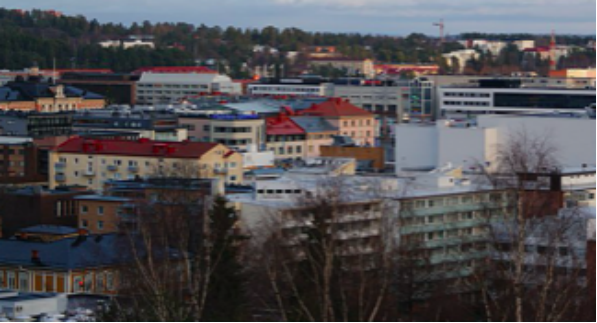
二、自然地理
1.地理条件
The city is surrounded by Lake Kallavesi, and several parts of it are built on islands. Kuopio's ample waterfronts and islands are also used in the Saaristokaupunki (lit. Archipelago city) -project, the biggest residential area currently being built in Finland. Saaristokaupunki will accommodate a total of 14,000 inhabitants in 2015. All houses will be situated no more than 500 metres (1,600 ft) from the nearest lakeshore.
Kuopio Market Square is the undisputed center of the city and the city center follows a densely built grid pattern with several parks and narrow gutter streets. The environment of the city is quite distinctive; the surface shapes of the waterfront-lined center are so variable that a flat property is a desired rarity. The settlement has spread outside the center of Kuopio according to a dense and sparse finger model that is affordable for public transport, and the new districts have been built in a municipal drive at once; for example, the Saaristokaupunki was banned for building for the previous 25 years, and this Kuopio zoning tradition has a long history. Due to the above-mentioned factors, the population density of the Kuopio city center is the highest in Finland. With the surrounding lakes, the shoreline in Kuopio is 4,760 kilometers. Of the Finnish municipalities, Kuopio has the second largest number of summer cottages and holiday homes. In 2013, the number of summer cottages was 8,684. The number of summer homes in Kuopio has increased in recent years due to municipal associations.
2.交通情况
The city has a nationally unique feature in its street network, where every other street is reserved for pedestrian and cycle traffic, so-called "rännikatu" (derived from the Swedish gränd, alley). These streets provide pedestrians a calm environment away from vehicular traffic. This setup dates back to Kuopio's first town plan by Pehr Kjellman in 1776. Originally, rännikadut were created as a fire barrier to prevent a possible fire escalating in a mainly wood-constructed city.
Two Finnish highways cross Kuopio: Finnish national road 5 (Vt 5; part of E63 in the northern side of city), which extends south to Helsinki and north to Sodankylä, and Finnish national road 9 (Vt 9; part of E63 in the western side of city), which extends west to Turku and east to the Niirala checkpoint on the Finnish-Russian border.
The Blue Highway passes through Kuopio. It is an international tourist route from Moi Rana, Norway to Pudozh, Russia via Sweden and Finland. Long-distance transport connections from Kuopio include Pendolino and InterCity trains from Kuopio railway station to several destinations around Finland, operated by VR, as well as multiple daily departures from Kuopio Airport on Finnair to Helsinki.
三、经济发展和规模
Kuopio is known as a strong center of health (e.g. it has the biggest yearly enrollment rate of medical students in Finland), pharmacy, environment, food & nutrition (all legalized Clinical and Public Health Nutritionists in Finland graduate from the University of Eastern Finland), safety (education in Emergency Services is centered in Kuopio ) and welfare professions, as the major organisations University of Kuopio (now part of the University of Eastern Finlandsince January 2010), Savonia University of Applied Sciences and Technopolis Kuopio are particularly oriented to those areas. There are about 4,200 enterprises in Kuopio, of which approximately 180 are export companies. These provide about 45,000 jobs.
At the end of 2016, there were a total of 50,877 jobs. The unemployment rate in Kuopio at the end of September 2018 was 9.6%, compared to 11.0% a year ago. The unemployment rate decreased by 1.4 percentage points compared to the end of September of the previous year. There were 752 fewer unemployed than in September of the previous year. 45,364 or 89.3% of the labor force was employed. The largest group of those outside the labor force are pensioners (25,056 people). The number of pensioners has increased by 13.1% in 10 years (2002–2012). The number of students since 2011 has been about 10,000. In 2011, 81.9% of jobs were in the services sector.
Health and social work services 10,755, trade, accommodation and food service activities 7,479, public administration and education 6,939, administrative and support service activities 3,588, construction 3,502, industry 3,400, professional, technical and scientific activities 2,771, transport and storage 2,573, other social and personal services 2,293, information and communication 1,522, agriculture, forestry and fishing 1,248, finance and insurance 875, real estate 548, mining, energy, water and environmental services 544 and unknown 497.
In 2011, 11.1% of male employees and 5.3% of female employees worked as entrepreneurs. There were a total of 3,934 entrepreneurs. The unemployment rate in Kuopio was 11.8% during January – June 2014. Among the comparison cities, Kuopio ranks fifth in terms of unemployment. Unemployment in Kuopio is below average compared to the whole country.
四、产业特点/重点项目
Kuopio has made itself known, for example, with the fish rooster, the Savo dialect and Puijo. The people of Kuopio have been associated with the adjective lust, which means benevolence, playfulness and enjoyment of life. Kuopio residents have also been considered false jaws, always looking for alternative linguistic expressions for their message.
Kuopio Market Square is the commercial center of the city. It is surrounded by banks, department stores (Carlson and Sokos) and shopping centers (Vihtori, Aapeli, Minna, H-talo, Sektor, IsoCee). The market itself sells some kind of goods, especially at market times, but the best-known products are probably fish roosters and meat pies. One of the best-known products of the market hall on the edge of the market, completed in 1902, especially among the locals, is probably the barley grater of Kotileipomo Hiltunen, which has been baked for two generations. There is also a lively restaurant and entertainment life near the market square in the square area.
During the summer seasons, the Kuopio passenger port area near the city center is also vibrant due to events held in its own market square, restaurants and restaurant ships, as well as tourism. The expansion of the port of Kuopio and several tourism projects in the area are underway.
According to the 2009 company survey of the Sarka - Creative North Savo project, there were 450 creative companies operating in Kuopio at that time, compared to a total of 900 in Northern Savonia as a whole. The most significant recent business projects are the centralization of Honeywell's Finnish operations in Kuopio, the completion of Ark Therapeutics' gene medicine plant, the marine industry concentration built by Bella-Vene in Marine Park Haapaniemi's Siikaniemi and the construction of Junttan's EUR 15 million assembly plant at Kylmämäki at the end of 2008. The site of Junttan's current factory in Särkilahti will have space for a large shopping center. The 9.7-hectare plot purchased by Savocon and TKD Finland for EUR 11 million has a building right for 58,500 square meters. The two companies plan to invest a total of around EUR 40 million in the site. A significant industrial player is also Savon Sellu Oy in Sorsasalo, which is currently owned by Powerflute Oyj. One of the biggest projects and investments of recent years is the preparation of the construction of Finnpulp's largest and most modern softwood pulp mill in Kuopio.
The most significant retail investments are the Prisma extension completed in December 2007 and the Päiväranta K-Citymarket completed in August 2008. The hardware store Kodin Terra was opened in Pitkälahti, as well as the Ikano Group's shopping center in the Matkus area in November 2012 and the IKEA department store earlier in the spring.
In 2012, retail premises were completed under the market square and the shopping hall, connecting the western, southern and eastern sides of the square with an underground shopping corridor. At the same time, the parking facility under the square was expanded. The promenade area was completed in the fall of 2014. The exterior renovation of the market hall was completed in November 2012 and the renovation of the interior in May 2013. The fish hall on the side of the market hall was demolished and a café building was built in its place.
Savilahti is home to Technopolis Kuopio, the Kuopio campus of the University of Eastern Finland, KYS, and in the future also Savonia University of Applied Sciences. Kuopio Science Park in Savilahti has grown rapidly throughout the 21st century. Technopolis Kuopio, located in the science park, is now a community of 3,000 jobs. Savonia University of Applied Sciences' 12,200-square-meter premises are now located on the Technopolis property. About 2,000 polytechnic students study in Savilahti. [133] In the 2020s, Savilahti will become a significant center of study and competence in Europe, for the needs of which an entire residential area will be built in the area. Projects and projects have started in the late 2010s. [134] There are currently more than 9,000 students and 10,000 jobs in the Savilahti area, but the number will increase by several thousand during the 2020s.
The Kuopio City Council approved a new strategy for the City of Kuopio on 11 December 2017. The strategy defines Kuopio's vision to be the capital of a good life. In the strategy, good life includes health, the vitality of the area and the wealth of everyday life.
The vision has been specified with goals that describe the city's desired target state in 2030:
A sustainable growth center of one million people - 200,000 inhabitants in 2040
Renewable and international business life and a good business climate
Savilahti Europe's most interesting learning and innovation environment
Finland's fastest growing meeting, event and tourism area
A pioneer in health, environmental and well-being expertise
Unique and inspiring in its environment. The best place for kids.
五、风景名胜,景点( attractions)
1. Kuopio Market Square
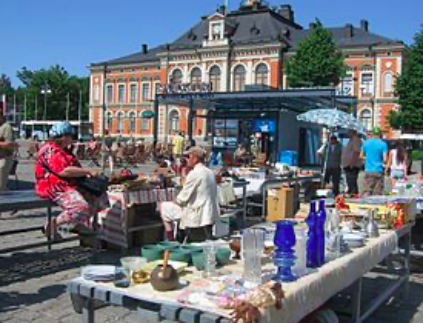
Kuopio's market square, or market square, is perhaps Kuopio's most famous attraction. The market has been located in its current location since 1818. It became a market square in 1856, when the market square moved to this location from the site of the former Kustaantori, now Snellman Park.
The market is located about one hundred meters above sea level and the size of the area is 130 × 174 meters. The cover is made of dice and nubile stone. In the east-west direction, the area is crossed by flat walkways. As a surface, the market is slightly sloping, which poses challenges for use. The structure rests on a 10–15 m deep sand mattress, under which there is a ridge formation starting from Väinölänniemi, which runs under the church towards Puijo. Along the edges of the square are Tulliportinkatu in the north, Puijonkatu in the east, Kauppakatu in the south and Haapaniemenkatu in the west.
2.Port of Kuopio
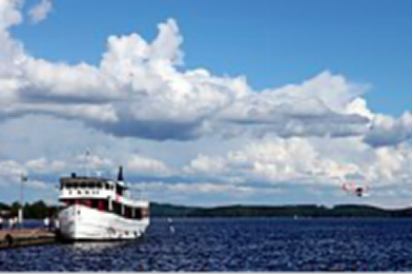
The Port of Kuopio (LOCODE: FI KUO [1]) usually refers to the joint designation of Kuopio passenger port and port area services in the Vahtivuori district of Kuopio. Cargo ship traffic to Kuopio takes place via the Kuopio cargo port, or Kumpusaari deepwater port, located in the Haapaniemi district; the cargo port is located about two kilometers southwest of the passenger port. In its broadest sense, the Port of Kuopio refers to both passenger and cargo ports with their ancillary activities.
Kuopio's passenger port is the busiest port for passenger traffic in the Vuoksi watershed and Lake Finland. There are many cruise companies and restaurants. In addition, the harbor market has stalls. The Kuopio Wine Festival is held at this market square. The Passenger Harbor area is one of the centers of summer Kuopio's tourism activities alongside Kuopio Market Square. The harbor is often filled with walkers admiring Kallavesi, market traders, diners on the terrace and those going on a cruise.
3. Kuopio Museum
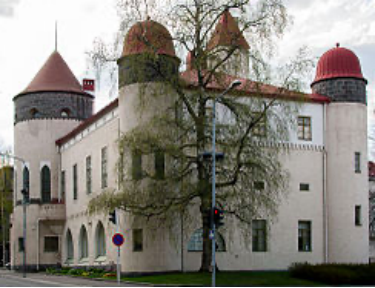
The Kuopio Museum is an Art Nouveau-style museum building completed in 1907 on the edge of Snellman Park in Kuopio, the former Kustaantori. The Kuopio Museum is the third oldest museum building in Finland after the Helsinki Ateneum (1887) and the Turku Art Museum (1904). It has national romantic features and has been inspired by Finnish castles such as Olavinlinna and Vyborg Castle. The architect was J. V. Strömberg, who designed a significant part of Kuopio's public buildings at the turn of the 20th century. The building was handed over for use on July 2, 1907.
The Kuopio Museum houses the Exhibition Facilities of the Kuopio Museum of Natural History and the Kuopio Museum of Cultural History. The building also housed the city library, until a new library building was erected on the adjacent plot in 1967 after a long handshake.
The Museum of Cultural History and the Museum of Natural History function as regional museums of responsibility. The museum is closed for renovations that began in 2018. At the same time, the museum will be connected to the adjacent library. The entity is scheduled to open to the public in the summer of 2021.
六、历史文化
1.历史
In the 1550s, under the influence of Mikael Agricola, a church and a parish were founded in Kuopionniemi. Governor Peter Brahe founded the city of Kuopio in 1653, but the official date is recognized as 17 November 1775, when King Gustav III of Sweden ordered the formal establishment of the city. The period of Russian rule (1809–1917) brought notable transportation development within Eastern Finland. The Saimaa Canal (1856) opened up a summer route towards the Baltic Sea, and the Savo railroad (1889) improved transport in winter.
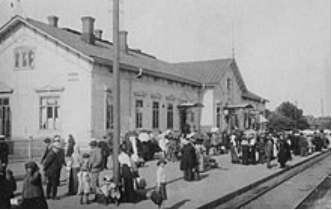
After the World War II, the city's population grew significantly, due in part to the settlement of Karelian evacuees and the high birth rate. The rapid growth of the population forced the expansion of schools; at the end of the 1940s, support was also provided for school transports and the provision of free school meals (the poor people had received it in Kuopio since 1902). The large number of young people and the occasional lack of activity also gave rise to various phenomena in the city, such as the Kuopio Market Riot in 1965. In the 1960s, the first construction of the actual suburb, Puijonlaakso, began. Since then, the new areas have each grown in turn: in the 1960s, Puijonlaakso and Tiihotar (as part of Saarijärvi); In the 1970s Saarijärvi, Kelloniemi and Levänen; In the 1980s, Jynkkä and Neulamäki. The municipality of Maaninka joined the city of Kuopio in 2015, the town of Nilsiä in 2013, and Karttula in 2011, as did Vehmersalmi in 2005, Riistavesi in 1973, and Kuopion maalaiskunta in 1969.
2. 文化体育
Kuopio has always been a city of education. Some of the first schools offering education in Finnish(such as the School for the Blind in 1871, and the Trade School in 1887) were established in Kuopio. Currently the most important institutions are the University of Eastern Finland, the Savonia University of Applied Sciences, Vocational College of Northern Savonia and the Kuopio department of the Sibelius Academy. One of the oldest schools in the city are Kuopio Lyceum High School, which was officially established in 1872, but was originally built in 1826 and designed by Carl Ludvig Engel.
Kuopio is known as the cultural center of Eastern Finland. One of the Kuopio's most important cultural venues are the Kuopio Museum and the Kuopio City Theatre in the city center. A wide range of musical (from kindergarten to doctorate-level studies) and dance education is available and the cultural life is active. Notable events include ANTI – Contemporary Art Festival, Kuopio Dance Festival, Kuopio Rockcock, Kuopio Wine Festival, Kuopio Marathon and Finland Ice Marathon in winter. A notable place, however, to enjoy the local flavor of Kuopio life and food is Sampo, a fish restaurant loved by locals and tourists as well. The city has a comprehensive hotel offer for tourism, one of the most notable is Hotel Savonia, part of the Best Western hotel chain, in the Puijonlaakso district. Kuopio is known for its association with a national delicacy, Finnish fish pastry (Kalakukko), and the dialect of Savo, as well as the hill of Puijo and the Puijo tower. Besides being a very popular outdoor recreation area, Puijo serves also as a stage for a yearly World Cup ski jumping competition.
In inhabitants of Kuopio have a special reputation: they are known as jovial and verbally joking. Within the Savo culture, the onus is placed on the listener to interpret the story. People of the Kuopio region and Eastern Finland have always had many health problems and the mortality has been higher than on an average in Finland. Because of this, Eastern Finland has been a hotspot for Public Health studies. The North Karelia Project by the University of Kuopio in coordination with the National Public Health Institute and the World Health Organization, beginning in the 1970s was one of its first steps towards world class research. During the 2000s, Kuopio has placed very well in a number of image, popularity and city-attractiveness surveys. In 2007 it was placed third, behind Tampere and Oulu.
Kuopio bid for the 2012 Winter Youth Olympics, a youth sports festival in the tradition of the Olympics. It became a finalist in November 2008, but ultimately lost to Innsbruck, Austria. Kuopio's image as a small city with a large University and many active young people was considered a model of what the International Olympic Committee seeks for the Games.
七、其他信息
Several explanations are behind the name Kuopio. The first is that in the 16th century, a certain influential person named Kauhanen in Tavinsalmichanged his name to Skopa and the people's pronunciation was Coopia and finally Cuopio. The second explanation is that it comes from the verb kuopia, meaning "paw", as when a horse paws the ground with its hoof. A third explanation is that it came from a certain Karelian man's name Prokopij, from Ruokolahti in the Middle Ages. This explanation is the most likely, and is supported by the Research Institute for the Languages of Finland.
八、联系方式
Town manager: Jarmo Pirhonen
Phone:+358 17 182 111
Email:kirjaamo @)kuopio.fi
Address:City of Kuopio, PO Box 228, 70101 Kuopio
https://www.kuopio.fi/en/yhteystiedot
